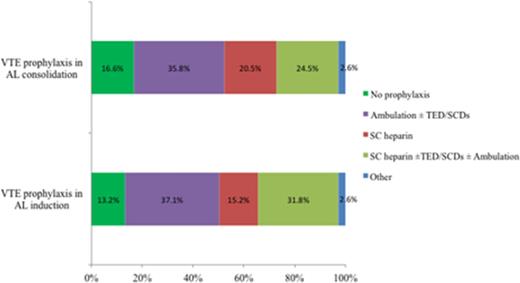Abstract
On behalf of the ECOG-ACRIN Cancer Research Group
Background: Venous thromboembolism (VTE) occurs in 2-12% of patients with acute leukemia (AL) despite disease and therapy-associated thrombocytopenia, and can be associated with significant morbidity and mortality. Due to limited high-quality studies, there are no evidence-based guidelines for VTE prophylaxis in this patient population. Based on our experience and the lack of consensus guidelines, we hypothesized that there would be a wide range in provider practice regarding methods of VTE prevention in patients with AL. To determine the current individual practices in North America, we devised a web-based survey of VTE prophylaxis practice among clinicians caring for patients with AL.
Methods: An anonymous 19 question web-based survey, approved by the Johns Hopkins Institutional Review Board, was distributed by email to members of the ECOG-ACRIN Cancer Research Group on 10/22/14. Four reminders were sent at two-week intervals with the survey closing on 12/8/14.
Results: Of the total 215 respondents, 64 were excluded for the following reasons: 52 did not directly manage medical care of AL patients, 3 referred AL patients to other centers, 5 left blank responses to all questions regarding VTE prophylaxis, 1 was a duplicate entry, and 3 described their position as support or office staff. One hundred fifty-one responses were eligible for analysis, with a response rate of 20.9% among physicians who treated leukemias. One hundred forty-seven were from the United States and 4 from Canada, representing 88 different institutions and 37 states or provinces. Overall, 47% and 45% of providers reported using pharmacologic VTE prophylaxis during induction and consolidation phases, respectively. Among the providers using pharmacologic prophylaxis, 60% designated 50,000/μL as the platelet count threshold below which they would hold prophylaxis and 26% used a platelet count of 30,000/μL. Fewer providers chose a platelet count of 20,000/μL (4%), 75,000/μL (4%), and 100,000/μL (2%). Lastly, 2% held prophylactic anticoagulation only in the setting of an active bleed and 2% reported variable thresholds. Approximately 15% of providers did not utilize any VTE prophylaxis while 36% used mechanical methods and ambulation. Among providers who did not recommend pharmacologic prophylaxis, the most commonly cited reasons were the perceived high risk of bleeding (51%), absence of data supporting use (38%), and perceived low risk of VTE (11%).
Conclusions: These results demonstrate wide variation in clinician practice regarding VTE prevention in hospitalized AL patients during induction and consolidation therapy. Our findings emphasize the need to develop standardized, evidence-based guidelines in this at-risk population.
VTE: venous thromboembolism, AL: acute leukemia, SC: subcutaneous, TED: thromboembolic deterrant stockings, SCD: sequential compression device
Practice patterns of VTE prophylaxis for AL patients during induction and consolidation therapies
Practice patterns of VTE prophylaxis for AL patients during induction and consolidation therapies
Barbarotta:Celgene, BMS, Novartis: Speakers Bureau. Prebet:CELGENE: Research Funding. Gore:Celgene: Consultancy, Honoraria, Research Funding.
Author notes
Asterisk with author names denotes non-ASH members.


This feature is available to Subscribers Only
Sign In or Create an Account Close Modal